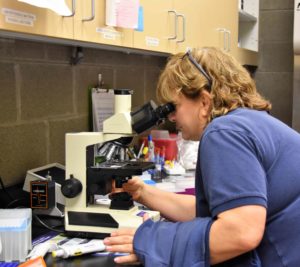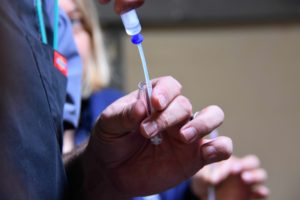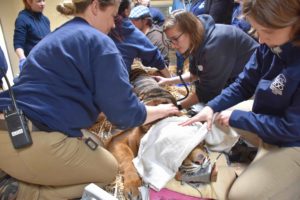Cross your paws. And think of tiger cubs!

Our endangered female Sumatran tigers, 5-year-old Kali and 4-year-old Kirana, could be pregnant. Both were artificially inseminated Jan. 30 with sperm from 14-year-old Mohan.
We won’t know for a few weeks if a pregnancy resulted, but if successful, tiger cubs would be born in May. But it is a big if. While artificial insemination has been done many times on tigers before, only four litters have been born.
“This is cutting-edge science, and artificial insemination is one of the critical tools we’re developing as we work to enhance the genetic diversity of the Sumatran tiger population in North America and increase the numbers of this critically endangered species,” said Zoo General Curator Dr. Karen Goodrowe, who holds a Ph.D. in reproductive physiology. Goodrowe also is vice chair of the Association of Zoos & Aquariums’ Sumatran tiger Species Survival Plan® managed breeding program.
A peek at the procedure

Dr. Jason Herrick, director of reproductive sciences at Omaha’s Henry Doorly Zoo and Aquarium, picked up a pipette, dipped it carefully into a plastic tube and extracted fresh Sumatran tiger semen for placement on a microscope slide. After locking the slide into place, he bent over the eyepieces and peered in, assessing the number and movement of sperm in the solution.
He liked what he saw. Sperm, their tails undulating rapidly, swam quickly in random patterns. The semen had just been collected from Mohan, Point Defiance Zoo & Aquarium’s oldest tiger – and one with valuable genetics to contribute to the U.S. population of his species.
Within an hour, Herrick and Dr. Bruce Christensen, a veterinarian who founded Kokopelli Assisted Reproductive Services in the Sacramento area, were bending over 5-year-old Sumatran tiger Kali. They worked methodically, carefully checking and rechecking their equipment and protocols before inseminating the anesthetized Kali with Mohan’s sperm. Dr. Christina Ploog, Associate Veterinarian at Henry Doorly Zoo, assisted the two.

As they worked, a team of more than a dozen veterinarians, veterinary technicians and keepers from Point Defiance Zoo & Aquarium watched over Kali. They trimmed her nails. Inspected and cleaned her paws. Assessed her mouth and teeth for dental issues. Administered fluids. Kept watch over her breathing. Listened to her heart. Peered into her eyes to evaluate them and kept them moist with a lubricant.
Once Kali’s insemination was complete, the team turned its attention to 4-year-old Kirana, the procedure repeated in similar fashion on a bed of straw in another tiger sleeping area behind the scenes at the Zoo’s Asian Forest Sanctuary.
Pairing science with tiger management

Why use artificial insemination instead of letting the tigers breed the old-fashioned way?
Mohan was recommended as a potential artificial insemination sire due to a history of aggression towards other tigers. A successful pregnancy would greatly boost the genetic mix in the North American population of Sumatran tigers.
Fecal samples from Kali and Kirana will be sent to a laboratory next week for testing that will determine whether ovulation occurred, Goodrowe said.
Determinations of possible pregnancies through fecal hormone analysis and ultrasounds won’t occur until sometime after the beginning of March.
“The tiger Species Survival Plan® has committed to developing the tools of semen collection, freezing/banking and using the sperm in artificial insemination, Goodrowe said. “We are hopeful to eventually use assisted reproductive technology to reliably aid in managing tiger populations.
“Each species is different, and it takes a lot of work to refine techniques so they’re reliable and repeatable,” she explained. ”
Semen also was collected and frozen from Bandar, the Zoo’s other male tiger, while the experts were in town.
Watch, wait – and try again?

All four tigers, Mohan, Bandar, Kali and Kirana, did well during the semen collection and artificial insemination sessions, said Point Defiance Zoo & Aquarium Head Veterinarian Dr. Karen Wolf. The procedures do not hurt the tigers, and each received a mini physical exam while sedated. Mohan also received laser therapy for arthritis in his neck. Two of the tigers will need dental follow-ups in the future.
Zoo staff collects blood from the tigers through voluntary behaviors, but anesthesia is needed for the hands-on exams that allow detailed dental assessments, x-rays, and an overall evaluation of all body systems , Wolf said.
And what if there is no pregnancy?
The Zoo will pair up 5-year-old Bandar with at least one of the females in the usual way to see if nature takes its course, Goodrowe said. So even if the AI didn’t take, there could still be the pitter-patter of little tiger paws in the Zoo’s future.